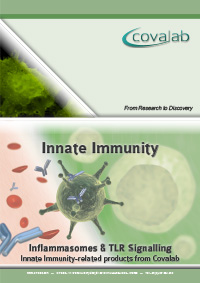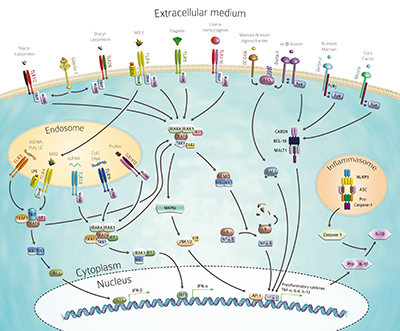We use cookies to make your experience better. To comply with the new e-Privacy directive, we need to ask for your consent to set the cookies. Learn more.
Innate Immunity
Innate Immunity-related products from Covalab
Innate immunity corresponds to the non-specific response of the organism to pathogens and is mediated by mast cells, phagocytes (macrophages, neutrophils and dendritic cells), basophils, eosinophils, NK cells as well as γδ T cells. This first line of defence is found in all class of plants and animals (vertebrate or not). It is based on the recognition of Pathogen-Associated Molecular Patterns (PAMPs) or endogenous danger signals through the sensing of Danger-Associated Molecular Patterns (DAMPs) by pattern recognition receptors 1 (PRRs). Activation of PRRs triggers cell signalling leading to the production of proinflammatory cytokines, chemokines and type 1 interferons, the induction of antimicrobial and inflammatory responses, pyroptotic cell death and the recruitment of phagocytic cells. These innate responses are responsible for efficient destruction and clearance of invading pathogens and other molecular threats and instructing the development of an appropriate pathogen-specific adaptive immune response.
Innate immune system comprises several classes of PRRs that allow the early detection of pathogens at the site of infection. The membrane-bound Toll-like receptors (TLRs) and C-type lectin receptors2 (CLRs) detect PAMPs in extracellular and endosomal compartments. TLRs and CLRs cooperate with PRRs sensing the presence of cytosolic nucleic acids like RIG-I like helicases/receptor (RLH/RLR). Another set of intracellular sensing PRRs are NOD-like receptors (NLRs) able to recognise PAMPs and DAMPs.
Upon stress (including infection and metabolic deregulation), certain NLRs form high molecular weight complexes called inflammasomes. These complexes associated with autophagy play a central role in controlling innate and adaptive immunity.
Browse our complete Innate immunity-related products range
Download Files

Download our dedicated brochure and find what you need among our innate immunity-related products!
References:
- 1 - Newton K, Dixit VM. Signaling in innate immunity and inflammation. Cold Spring Harb Perspect Biol. 2012 Mar 1; 4(3).
- 2 - Mason CP, Tarr AW. Human lectins and their roles in viral infections. Molecules. 2015 Jan 29; 20(2): 2229-71.
- 3 - Olive C. Pattern recognition receptors: sentinels in innate immunity and targets of new vaccine adjuvants. Expert Rev Vaccines. 2012 Feb; 11(2): 237-56.
- 4 - Latz E et al. Activation and regulation of the inflammasomes. Nat Rev Immunol. 2013 Jun; 13(6): 397-411.
- 5 - Stutz A, Golenbock DT, Latz E. Inflammasomes: too big to miss. J Clin Invest. 2009 Dec; 119(12): 3502-11.
- 6 - Hornung V, Latz E. Critical functions of priming and lysosomal damage for NLRP3 activation. Eur J Immunol. 2010 Mar; 40(3): 620-3.
- 7 - Schroder K, Tschopp J. The inflammasomes. Cell. 2010 Mar 19; 140(6): 821-32.
- 8 - Sturge CR et al. TLR-independent neutrophil-derived IFN-γ is important for host resistance to intracellular pathogens. Proc Natl Acad Sci USA. 2013 Jun 25; 110(26): 10711-6.
- 9 - Lamkanfi M, Dixit VM. Inflammasomes and their roles in health and disease. Annu Rev Cell Dev Biol. 2012; 28: 137-61.
- 10 - Stienstra R et al. The inflammasome puts obesity in the danger zone. Cell Metab. 2012 Jan 4; 15(1): 10-8.
- 11 - Kawasaki T, Kawai T. Toll-like receptor signaling pathways. Front Immunol. 2014 Sep 25; 5: 461.
- 12 - Akira S et al. Pathogen recognition and innate immunity. Cell.2006; 124: 783-801.
- 13 - Blasius AL et al. Intracellular toll-like receptors. Immunity. 2010; 32: 305-15.
- 14 - Zang SY et al. TLR3 deficiency in patients with herpes simplex encephalitis. Science. 2007; 317: 1522-7.
- 15 - Bernard JJ et al. Ultraviolet radiation damages self noncoding RNA and is detected by TLR3. Nat Med. 2012; 18: 1286-92.
- 16 - Takemura N et al. Blockade of TLR3 protects mice from lethal radiation-induced gastrointestinal syndrome. Nat Comm. 2014; 5: 3492.
- 17 - Coban C et al. Immunogenicity of whole-parasite vaccines against Plasmodium falciparum involves malarial hemozoin and host TLR9. Cell Host Microbe. 2010; 7: 50-61.
- 18 - Koblansky AA et al. Recognition of profilin by Toll-like receptor 12 is critical for host resistance to Toxoplasma gondii. Immunity. 2013 Jan 24; 38(1): 119-30.
- 19 - Unger WW et al. Glycan-modified liposomes boost CD4+ and CD8+ T-cell responses by targeting DC-SIGN on dendritic cells. J Control Release. 2012; 160: 88–95.
- 20 - Zhao XQ et al. C-type lectin receptor dectin-3 mediates trehalose 6,6’-dimycolate (TDM)-induced Mincle expression through CARD9/Bcl10/MALT1-dependent nuclear factor (NF)-κB activation. J Biol Chem. 2014 Oct 24; 289(43): 30052-62.

